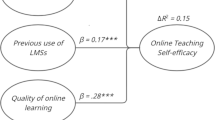Abstract
Through this study we sought to gain understanding of the challenges professors face as they make the transition to teaching online. We measured professors’ online teaching self-efficacy using survey research methods. Results showed that online teaching self-efficacy was high among the professors surveyed with no self-efficacy scores lower than 3.69 out of 5. The perception of student learning was the independent variable with the greatest impact on self-efficacy. Other variables that had a significant relationship with self-efficacy sub-scales were semesters taught online, future interest in teaching online, gender, satisfaction with teaching online, and academic discipline. The results suggest directions for faculty development interventions such as training and support structures.
Similar content being viewed by others
References
Allen, I. E., & Seaman, J. (2014). Grade change: Tracking online education in the United States. Newburyport, MA: The Sloan Consortium.
Bandura, A. (1977). Self-efficacy: Toward a unifying theory of behavioral change. Psychological Review, 84, 191–215.
Bandura, A. (1997). Self-efficacy: The exercise of control. New York, NY: Freeman.
Bawane, J., & Spector, J. (2009). Prioritization of online instructor roles: Implications for competency-based teacher education programs. Distance Education, 30, 383–397.
Berge, Z. L. (1995). Facilitating computer conferencing: Recommendations from the field. Educational Technology, 35, 22–30.
Berge, Z. L. (1998). Barriers to online teaching in post-secondary institutions. Can policy change fix it? Online Journal of Distance Learning Administration, 1(2). Summer. Retrieved from http://www.westga.edu/~distance/Berge12.html
Chang, T. S., Lin, H. H., & Song, M. M. (2011). University faculty members’ perceptions of their teaching efficacy. Innovations in Education and Teaching International, 48, 49–60.
Hogan, R. L., & McKnight, M. A. (2007). Exploring burnout among university online instructors: An initial investigation. The Internet and Higher Education, 10(5), 117–124.
Lee, M. H., & Tsai, C. C. (2010). Exploring teachers’ perceived self efficacy and technological pedagogical content knowledge with respect to educational use of the World Wide Web. Instructional Science, 38, 1–21.
Liu, S., Kim, K. J., Bonk, C. J., & Magjuka, R. (2007). What do online MBA professors have to say about online teaching? Online Journal of Distance Learning Administration, 10(2). Retrieved from http://www.westga.edu/~distance/ojdla/summer102/liu102.htm
Mehdinezhad, V. (2012). Faculty members’ understanding of teaching efficacy criteria and its relation to their characteristics. International Journal of Instruction, 5, 213–236.
Mishra, P., & Koehler, M. J. (2006). Technological pedagogical content knowledge: A new framework for teacher knowledge. Teachers College Record, 108, 1017–1054.
Moore, J. C. (2005). The Sloan Consortium quality framework and the five pillars. Newburyport, MA: The Sloan Consortium.
Perreault, H., Waldman, L., & Zhao, M. A. (2002). Overcoming barriers to successful delivery of distance-learning courses. Journal of Education for Business, 77, 314–318.
Presno, C. (1998). Taking the byte out of Internet anxiety: Instructional techniques that reduce computer/Internet anxiety in the classroom. Journal of Educational Computing Research, 18, 147–161.
Radford, A.W. (2011). Learning at a distance: Undergraduate enrollment in distance education courses and degree programs (NCES 2012-154). Retrieved from http://nces.ed.gov/pubs2012/2012154.pdf
Robinia, K. (2008). The effect of online teaching self-efficacy on nurse faculty teaching in public, accredited nursing programs in the state of Michigan. Unpublished Dissertation, Western Michigan University, Kalamazoo, MI.
Robinia, K. A., & Anderson, M. L. (2010). Online teaching efficacy of nurse faculty. Journal of Professional Nursing, 26, 168–175.
Shea, P. (2007). Bridges and barriers to teaching online college courses: A study of experienced online faculty in thirty-six colleges. Journal of Asynchronous Learning Environments, 11(2), 73–128.
Tschannen-Moran, M., & Hoy, A. W. (2001). Teacher efficacy: Capturing an elusive construct. Teaching and Teacher Education, 17, 783–805.
Tschannen-Moran, M., Hoy, A. W., & Hoy, W. K. (1998). Teacher efficacy: Its meaning and measure. Review of Educational Research, 68, 202–248.
Author information
Authors and Affiliations
Corresponding author
Rights and permissions
About this article
Cite this article
Horvitz, B.S., Beach, A.L., Anderson, M.L. et al. Examination of Faculty Self-efficacy Related to Online Teaching. Innov High Educ 40, 305–316 (2015). https://doi.org/10.1007/s10755-014-9316-1
Published:
Issue Date:
DOI: https://doi.org/10.1007/s10755-014-9316-1




